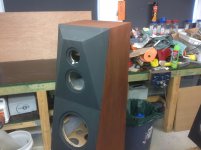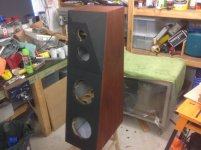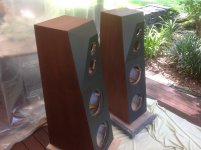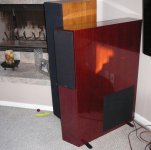Been trying to figure out how to minimize diffraction on my front baffle. Some people say you can't hear "diffraction". Let's assume you can't hear it, but I think you can definitely see it that is in term of image on the soundstage. A poorly design baffle (think big boxy speaker) can't hide itself very well, whereas a small monitor can more easily disappear. Not only that, big boxy speakers tend to have image that moves around a bit more. Wide baffle speakers like those of Sonus Faber tend to wander around especially at low frequency. But it does not mean that a large speaker can't disappear but it depends on the implementation. One of my favorite design is the Thiel CS 2.4. It has a rounded baffle to minimize diffraction. I listened to them once and it may have had the best soundstage I've ever heard. I think I'll do an Avalon style on my next speakers since rounded baffle like the Thiel is a litte hard for DIYers.
I was peripherally involved with a few speaker designs about twenty years ago.Some people say you can't hear "diffraction". Let's assume you can't hear it, but I think you can definitely see it that is in term of image on the soundstage.
One prototype speaker had a flat front baffle about 215 mm / 8.5" wide, with the tweeter mounted on the centreline. When measuring polar frequency responses, we found some dips and peaks at frequencies and angles that corresponded to two sound sources about 215 mm apart.
As a mental visualization, it was behaving as though the high frequency sound waves flowed along the front surface of the enclosure, and then "lit up" the edges of the enclosure, which then re-radiated the sound forwards (as well as sideways.)
Radiusing the vertical edges of the enclosure, and changing to a tweeter which had a short wide horn built into its faceplate to control dispersion, solved the problem. Those little dips vanished from the polar responses.
And yes, this did make for a noticeably wider "sweet spot" for listening.
-Gnobuddy
Been trying to figure out how to minimize diffraction on my front baffle. Some people say you can't hear "diffraction".
I do hear diffraction. The culprit is the dome tweeter.
When I cross it low, there will come a time when there's this "Glare" in the vocals. I attribute this to the tweeter's low frequencies bouncing off the front panel. This diffraction is the one I find most irritating.
There's another diffraction that occurs at the edge of the front panel. This is dependent on the panel's width. You will see a notch in the FR sweep around 2.5Khz ~ 4khz.
And there's a third one if the dome tweeter is not flush mounted. The notch is seen higher up in the FR plot, about 8kHz where the tweeter's faceplate and front panel creates a step.
Like Gnobuddy said, you can avoid all these by using a horn.
All my recent speaker projects have diffraction control as a priority. I take my inspiration from the Harry Olson resultsBeen trying to figure out how to minimize diffraction on my front baffle. Some people say you can't hear "diffraction". Let's assume you can't hear it, but I think you can definitely see it that is in term of image on the soundstage. A poorly design baffle (think big boxy speaker) can't hide itself very well, whereas a small monitor can more easily disappear. Not only that, big boxy speakers tend to have image that moves around a bit more. Wide baffle speakers like those of Sonus Faber tend to wander around especially at low frequency. But it does not mean that a large speaker can't disappear but it depends on the implementation. One of my favorite design is the Thiel CS 2.4. It has a rounded baffle to minimize diffraction. I listened to them once and it may have had the best soundstage I've ever heard. I think I'll do an Avalon style on my next speakers since rounded baffle like the Thiel is a litte hard for DIYers.
http://www.aes.org/aeshc/pdf/how.the.aes.began/olson_direct-radiator-loudspeaker-enclosures.pdf
Figure 2L and Figure 17 which are almost as good as for the sphere Figure 2A and Figure 6. My experience is that the improvement to imaging is very noticeable but the crossover needs to be optimised too. In my case this requires active crossover with adjustable driver delays. You do get a very distinct "hot seat", so they are not very "social" speakers.
Attachments
Some people say you can't hear "diffraction".
-well, you can hear the effects of diffraction with loudspeakers.
Of course where you are *least* likely to hear diffraction effects are when you are operating the driver about an octave or more below the pass-band where most diffractive artifacts to direct sound occur.
Ex. 2kHz represents about 7 inches, so assuming a 7 inch wide baffle (particularly if its only 7 inches high), then freq.s below at *least* 1kHz - are far less likely to be audible. (..baffle width being far more particular to Stereo effects with respect to the listener.)
As for actually seeing diffraction: do a search on "Schlieren".
If the sound pressure is high enough you can also see it with a "smoke flow".
-btw, waveguides/horns generally INCREASE diffraction, only potentially improving a particular aspect of the result (which may be favorable to the overall design).
Last edited:
If the sound pressure is high enough you can also see it with a "smoke flow".
These are speakers, not two jet engines.
All my recent speaker projects have diffraction control as a priority. I take my inspiration from the Harry Olson results
http://www.aes.org/aeshc/pdf/how.the.aes.began/olson_direct-radiator-loudspeaker-enclosures.pdf
Mine will look similar but even the bass cab will get chamfered (like that of your mid cab) as well since the bass may extend to the midrange frequencies.
These are speakers, not two jet engines.
..overall extreme spl not required.
Ex. smoke ring generators rely on diffraction.
My woofers only operate up to 200 Hz where diffraction is not such an issue. As a rule I try to use the mid-range over as wide a frequency range as it is comfortable with. This means I spend a lot of effort in choosing very capable mid-drivers. This is harder than it might seem because so many contenders are actually mid-woofers, which compromises the performance higher up near the mid-tweeter crossover.Mine will look similar but even the bass cab will get chamfered (like that of your mid cab) as well since the bass may extend to the midrange frequencies.
My practical experimentation with diffraction is exampliefied by this sketch (Fonkens for the FF105wk),
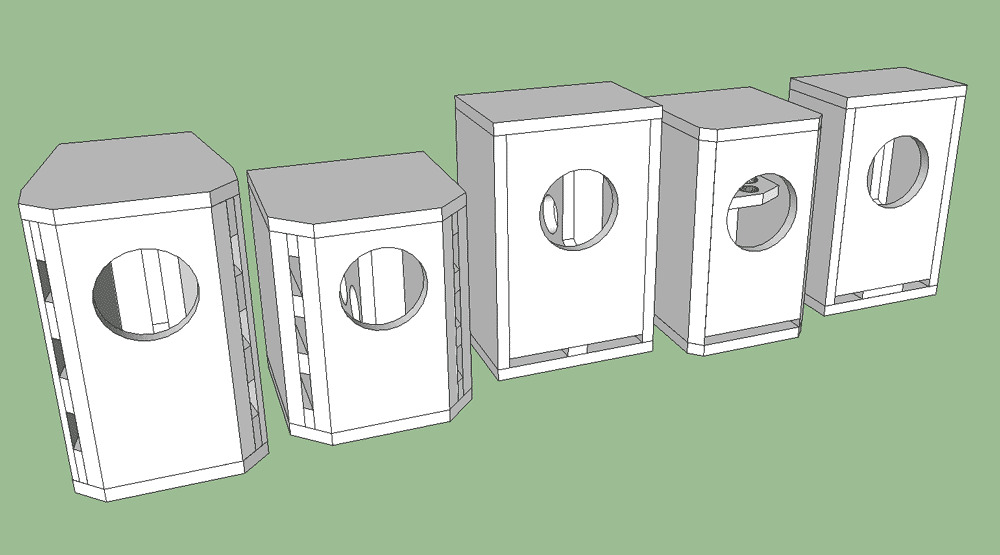
The 3 images on the left are all 5 litres and all have the same tuning… they are just different shapes. As one moves from the rectangular CGR, to the rectangular box with big side chamfers, to the trapezoidal box with not only large side chamfers but a narrowing at the back that make sthe plan a crude tear shape, the diffraction signature decreases and the ability of the box to audiably “disappear” increases.
dave

The 3 images on the left are all 5 litres and all have the same tuning… they are just different shapes. As one moves from the rectangular CGR, to the rectangular box with big side chamfers, to the trapezoidal box with not only large side chamfers but a narrowing at the back that make sthe plan a crude tear shape, the diffraction signature decreases and the ability of the box to audiably “disappear” increases.
dave

special photographic method known as Schlieren Photography which shows us the sound wave as it travels through the air....
image filmed by Drs. Michael Hargather and Gary Settles at Penn State University.
http://www.themobilestudio.net/the-fourier-transform-part-2
......Ex. smoke ring generators rely on diffraction.

Last edited:
Well, there are graphs showing a tweeter's response and felt.
Diffraction Doesn't Have to be a Problem
I've used open cell foam.
Felt or foam walled waveguide?
Speaker cabinets and edge diffraction
I've also had luck catching horn reflections.
Stereo-Lab cf400/cf250 Tactrix or Jabo KH-55 Exponential Horn for Radian 950PB
Makes it sound less "live", then you learn that what you were hearing was reflections adding something that shouldn't be there.
Diffraction Doesn't Have to be a Problem
I've used open cell foam.
Felt or foam walled waveguide?
Speaker cabinets and edge diffraction
I've also had luck catching horn reflections.
Stereo-Lab cf400/cf250 Tactrix or Jabo KH-55 Exponential Horn for Radian 950PB
Makes it sound less "live", then you learn that what you were hearing was reflections adding something that shouldn't be there.
To my understanding you can either offset the tweeter or place the tweeter at the middle line of the baffle.
If you look a Troels Gravesens speakers, many of them have the tweeter placed very close to the top of the baffle. By experiment I have found this to work out well too. It also depends on the specific tweeter - At least to some extent.
If you offset the tweeter, you will not have a even response on both side of the speaker. Ie to the right and to the left. In practice this may not be a problem at all.
In the end I would say that you need to experiment with it. Cheap cardboard is fine for those experiments. ALSO it is important to measure in different degrees relative to the baffle.
If you look a Troels Gravesens speakers, many of them have the tweeter placed very close to the top of the baffle. By experiment I have found this to work out well too. It also depends on the specific tweeter - At least to some extent.
If you offset the tweeter, you will not have a even response on both side of the speaker. Ie to the right and to the left. In practice this may not be a problem at all.
In the end I would say that you need to experiment with it. Cheap cardboard is fine for those experiments. ALSO it is important to measure in different degrees relative to the baffle.
If the diffraction occurs close to the source, it becomes more difficult to hear as a separate event. It happens nonetheless.have the tweeter placed very close to the top of the baffle.
You can make the response appear more flat along an axis, but this doesn't reduce diffraction.If you offset the tweeter
A flat baffle is a waveguide, in that it follows the bounds of a wavefront whilst allowing for natural expansion. It is when this changes that there may be a problem.-btw, waveguides/horns generally INCREASE diffraction, only potentially improving a particular aspect of the result (which may be favorable to the overall design).
All my recent speaker projects have diffraction control as a priority. I take my inspiration from the Harry Olson results
http://www.aes.org/aeshc/pdf/how.the.aes.began/olson_direct-radiator-loudspeaker-enclosures.pdf
Figure 2L and Figure 17 which are almost as good as for the sphere Figure 2A and Figure 6. My experience is that the improvement to imaging is very noticeable but the crossover needs to be optimised too. In my case this requires active crossover with adjustable driver delays. You do get a very distinct "hot seat", so they are not very "social" speakers.
Epic build! Have you also found that a slanted baffle does only good for the bass? (and obviously the midrange so that you listen slighly off axis where every single speaker in the world sounds better)
Another thing I have found is that a speaker produces better bass IF the baffle goes all the way down to the floor. If you raise the speaker with spikes or so, it seems that some of the sound travels back under the speaker. Not sure if I can measure a difference with my mic, but there is no doubt in my mind, that there is a difference. And it is not neglible. The impact and tactile of the bass is better. Then imagine what happens with a two-way, where there is a slanted stand all the way down to the floor. I even think that way back in time, such a device was sold by Wilson Audio.
For DIYers, I think the Thiel CS2.4 is probably the easiest to duplicate. The ones from B&W may be a bit difficult.
An externally hosted image should be here but it was not working when we last tested it.
An externally hosted image should be here but it was not working when we last tested it.
It may be an optical illusion but the rear and mid-tweeter baffle are vertical and the bass baffle is leaning backwards. So actually the listening position is horizontal with the tweeter. The speaker is toed-in to preference. The new photo hopefully makes this clearer.Epic build! Have you also found that a slanted baffle does only good for the bass? (and obviously the midrange so that you listen slighly off axis where every single speaker in the world sounds better)
Bass performance is better at low frequencies when the baffle is extended towards the room boundaries (wall, floor or both). This is often called the Allison Boundary Effect, after Roy Allison. It was used in the NHT 3.3 and 2.9 for exceptional bass performance. It was a bit limiting in that the speaker worked best hard up against the front wall. To keep this thread on topic, NHT also used foam strips to mask the cabinet edge diffraction. I have never been quite convinced by the use of felt or foam to control edge diffraction. It always seemed too hit-and-miss to me, although many swear by it. The Olson results are pretty definitive but the cabinet construction is not simple. If I had the capability, large radius edges would be my preference but chamfers get pretty close.Another thing I have found is that a speaker produces better bass IF the baffle goes all the way down to the floor. If you raise the speaker with spikes or so, it seems that some of the sound travels back under the speaker. Not sure if I can measure a difference with my mic, but there is no doubt in my mind, that there is a difference. And it is not neglible. The impact and tactile of the bass is better. Then imagine what happens with a two-way, where there is a slanted stand all the way down to the floor. I even think that way back in time, such a device was sold by Wilson Audio.
Attachments
- Status
- This old topic is closed. If you want to reopen this topic, contact a moderator using the "Report Post" button.
- Home
- Loudspeakers
- Multi-Way
- You may not hear "diffraction" but can you see "diffraction"?
